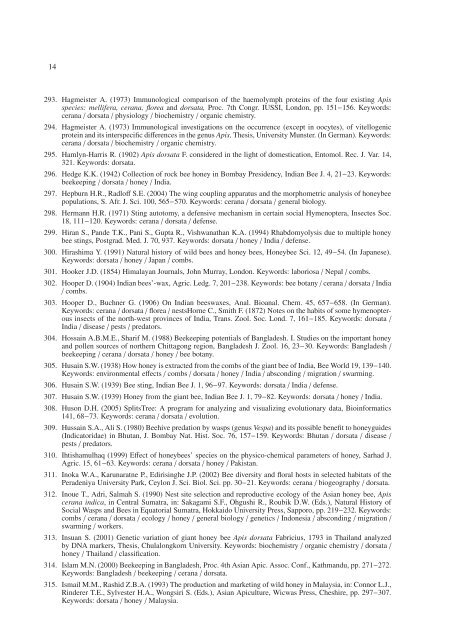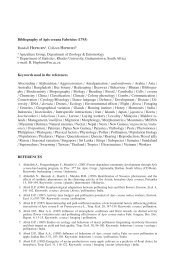H. Randall Hepburn, Colleen - Apidologie
H. Randall Hepburn, Colleen - Apidologie
H. Randall Hepburn, Colleen - Apidologie
You also want an ePaper? Increase the reach of your titles
YUMPU automatically turns print PDFs into web optimized ePapers that Google loves.
14<br />
293. Hagmeister A. (1973) Immunological comparison of the haemolymph proteins of the four existing Apis<br />
species: mellifera, cerana, florea and dorsata, Proc. 7th Congr. IUSSI, London, pp. 151−156. Keywords:<br />
cerana / dorsata / physiology / biochemistry / organic chemistry.<br />
294. Hagmeister A. (1973) Immunological investigations on the occurrence (except in oocytes), of vitellogenic<br />
protein and its interspecific differences in the genus Apis, Thesis, University Munster. (In German). Keywords:<br />
cerana / dorsata / biochemistry / organic chemistry.<br />
295. Hamlyn-Harris R. (1902) Apis dorsata F. considered in the light of domestication, Entomol. Rec. J. Var. 14,<br />
321. Keywords: dorsata.<br />
296. Hedge K.K. (1942) Collection of rock bee honey in Bombay Presidency, Indian Bee J. 4, 21−23. Keywords:<br />
beekeeping / dorsata / honey / India.<br />
297. <strong>Hepburn</strong> H.R., Radloff S.E. (2004) The wing coupling apparatus and the morphometric analysis of honeybee<br />
populations, S. Afr. J. Sci. 100, 565−570. Keywords: cerana / dorsata / general biology.<br />
298. Hermann H.R. (1971) Sting autotomy, a defensive mechanism in certain social Hymenoptera, Insectes Soc.<br />
18, 111−120. Keywords: cerana / dorsata / defense.<br />
299. Hiran S., Pande T.K., Pani S., Gupta R., Vishwanathan K.A. (1994) Rhabdomyolysis due to multiple honey<br />
bee stings, Postgrad. Med. J. 70, 937. Keywords: dorsata / honey / India / defense.<br />
300. Hirashima Y. (1991) Natural history of wild bees and honey bees, Honeybee Sci. 12, 49−54. (In Japanese).<br />
Keywords: dorsata / honey / Japan / combs.<br />
301. Hooker J.D. (1854) Himalayan Journals, John Murray, London. Keywords: laboriosa / Nepal / combs.<br />
302. Hooper D. (1904) Indian bees’-wax, Agric. Ledg. 7, 201−238. Keywords: bee botany / cerana / dorsata / India<br />
/ combs.<br />
303. Hooper D., Buchner G. (1906) On Indian beeswaxes, Anal. Bioanal. Chem. 45, 657−658. (In German).<br />
Keywords: cerana / dorsata / florea / nestsHorne C., Smith F. (1872) Notes on the habits of some hymenopterous<br />
insects of the north-west provinces of India, Trans. Zool. Soc. Lond. 7, 161−185. Keywords: dorsata /<br />
India / disease / pests / predators.<br />
304. Hossain A.B.M.E., Sharif M. (1988) Beekeeping potentials of Bangladesh. I. Studies on the important honey<br />
and pollen sources of northern Chittagong region, Bangladesh J. Zool. 16, 23−30. Keywords: Bangladesh /<br />
beekeeping / cerana / dorsata / honey / bee botany.<br />
305. Husain S.W. (1938) How honey is extracted from the combs of the giant bee of India, Bee World 19, 139−140.<br />
Keywords: environmental effects / combs / dorsata / honey / India / absconding / migration / swarming.<br />
306. Husain S.W. (1939) Bee sting, Indian Bee J. 1, 96−97. Keywords: dorsata / India / defense.<br />
307. Husain S.W. (1939) Honey from the giant bee, Indian Bee J. 1, 79−82. Keywords: dorsata / honey / India.<br />
308. Huson D.H. (2005) SplitsTree: A program for analyzing and visualizing evolutionary data, Bioinformatics<br />
141, 68−73. Keywords: cerana / dorsata / evolution.<br />
309. Hussain S.A., Ali S. (1980) Beehive predation by wasps (genus Vespa) and its possible benefit to honeyguides<br />
(Indicatoridae) in Bhutan, J. Bombay Nat. Hist. Soc. 76, 157−159. Keywords: Bhutan / dorsata / disease /<br />
pests / predators.<br />
310. Ihtishamulhaq (1999) Effect of honeybees’ species on the physico-chemical parameters of honey, Sarhad J.<br />
Agric. 15, 61−63. Keywords: cerana / dorsata / honey / Pakistan.<br />
311. Inoka W.A., Karunaratne P., Edirisinghe J.P. (2002) Bee diversity and floral hosts in selected habitats of the<br />
Peradeniya University Park, Ceylon J. Sci. Biol. Sci. pp. 30−21. Keywords: cerana / biogeography / dorsata.<br />
312. Inoue T., Adri, Salmah S. (1990) Nest site selection and reproductive ecology of the Asian honey bee, Apis<br />
cerana indica, in Central Sumatra, in: Sakagami S.F., Ohgushi R., Roubik D.W. (Eds.), Natural History of<br />
Social Wasps and Bees in Equatorial Sumatra, Hokkaido University Press, Sapporo, pp. 219−232. Keywords:<br />
combs / cerana / dorsata / ecology / honey / general biology / genetics / Indonesia / absconding / migration /<br />
swarming / workers.<br />
313. Insuan S. (2001) Genetic variation of giant honey bee Apis dorsata Fabricius, 1793 in Thailand analyzed<br />
by DNA markers, Thesis, Chulalongkorn University. Keywords: biochemistry / organic chemistry / dorsata /<br />
honey / Thailand / classification.<br />
314. Islam M.N. (2000) Beekeeping in Bangladesh, Proc. 4th Asian Apic. Assoc. Conf., Kathmandu, pp. 271−272.<br />
Keywords: Bangladesh / beekeeping / cerana / dorsata.<br />
315. Ismail M.M., Rashid Z.B.A. (1993) The production and marketing of wild honey in Malaysia, in: Connor L.J.,<br />
Rinderer T.E., Sylvester H.A., Wongsiri S. (Eds.), Asian Apiculture, Wicwas Press, Cheshire, pp. 297−307.<br />
Keywords: dorsata / honey / Malaysia.




